Digital Image Correlation Structural Strain Analysis of S235 Fillet-Welded Joints under Low-Cycle Fatigue Loadings
Abstract
1. Introduction
2. Low-Cycle Fatigue Tests
- Image acquisition: high-resolution digital images are captured before and after deformation or motion using cameras.
- Image preprocessing: the acquired images undergo preprocessing to enhance contrast, remove noise, or improve quality based on specific application requirements.
- Image correlation: DIC relies on pixel intensity or a pattern comparison between reference and deformed images. Algorithms analyze subsets of pixels in both images to determine displacement and deformation.
- Deformation analysis: calculated displacements quantify deformation and strain on an object’s surface, often represented as a color-coded strain map.
- Full-field results: DIC excels at providing full-field measurements, offering deformation information for every point on the analyzed surface, unlike traditional point-wise techniques. DIC boasts several advantages: it is a non-contact and optical technique, making it suitable for delicate or sensitive materials, it provides a high spatial resolution for detailed surface deformation analysis, and it is applicable to a broad spectrum of materials and structures.
3. Structural Strain Approach
3.1. Structural Strain Approach Definition for FEA
3.2. DIC—Equivalent Structural Strain
- Measure the longitudinal strains on the specimen surface.
- Perform a linear fitting of the previous longitudinal strains between x/t = 0.4 and x/t = 1.
- Evaluate the structural strains ( and ) at the max and min loads by intersecting the previous linear fit with the x-axis.
- Evaluate from Equation (10).
- Considering that the membrane strain is given by Equation (8), the bending strain can be calculated using Equation (5): .
- Calculate r and I(r) from Equations (7) and (8).
- Evaluate from Equation (6) and match it with the number of cycles to failure.
- Compare the result to the ASME curve.
4. Conclusions
Author Contributions
Funding
Institutional Review Board Statement
Informed Consent Statement
Data Availability Statement
Conflicts of Interest
References
- Dong, Y.; Garbatov, Y.; Soares, C.G. Recent Developments in Fatigue Assessment of Ships and Offshore Structures. J. Mar. Sci. Appl. 2022, 21, 3–25. [Google Scholar] [CrossRef]
- Garbatov, Y.; Guedes Soares, C. Uncertainty Assessment of Fatigue Damage of Welded Ship Structural Joints. Eng. Struct. 2012, 44, 322–333. [Google Scholar] [CrossRef]
- Dong, Y.; Garbatov, Y.; Guedes Soares, C. Improved Effective Notch Strain Approach for Fatigue Reliability Assessment of Load-Carrying Fillet Welded Cruciform Joints in Low and High Cycle Fatigue. Mar. Struct. 2021, 75, 102849. [Google Scholar] [CrossRef]
- Corigliano, P. On the Compression Instability during Static and Low-Cycle Fatigue Loadings of AA 5083 Welded Joints: Full-Field and Numerical Analyses. J. Mar. Sci. Eng. 2022, 10, 212. [Google Scholar] [CrossRef]
- Hobbacher, A.F. The New IIW Recommendations for Fatigue Assessment of Welded Joints and Components—A Comprehensive Code Recently Updated. Int. J. Fatigue 2009, 31, 50–58. [Google Scholar] [CrossRef]
- Corigliano, P.; Cucinotta, F.; Guglielmino, E.; Risitano, G.; Santonocito, D. Thermographic Analysis during Tensile Tests and Fatigue Assessment of S355 Steel. Procedia Struct. Integr. 2019, 18, 280–286. [Google Scholar] [CrossRef]
- Greco, A.; Sgambitterra, E.; Furgiuele, F. A New Methodology for Measuring Residual Stress Using a Modified Berkovich Nano-Indenter. Int. J. Mech. Sci. 2021, 207, 106662. [Google Scholar] [CrossRef]
- Corigliano, P.; Crupi, V.; Fricke, W.; Friedrich, N.; Guglielmino, E. Experimental and Numerical Analysis of Fillet-Welded Joints under Low-Cycle Fatigue Loading by Means of Full-Field Techniques. Proc. Inst. Mech. Eng. C J. Mech. Eng. Sci. 2015, 229, 1327–1338. [Google Scholar] [CrossRef]
- Fricke, W. Recent Developments and Future Challenges in Fatigue Strength Assessment of Welded Joints. Proc. Inst. Mech. Eng. C J. Mech. Eng. Sci. 2015, 229, 1224–1239. [Google Scholar] [CrossRef]
- Baumgartner, J. Review and Considerations on the Fatigue Assessment of Welded Joints Using Reference Radii. Int. J. Fatigue 2017, 101, 459–468. [Google Scholar] [CrossRef]
- Braun, M.; Ehlers, S. Review of Methods for the High-Cycle Fatigue Strength Assessment of Steel Structures Subjected to Sub-Zero Temperature. Mar. Struct. 2022, 82, 103153. [Google Scholar] [CrossRef]
- Hobbacher, A. Fatigue Design of Welded Joints and Components; Woodhead Publishing: Cambridge, UK, 1996; ISBN 1855733153. [Google Scholar]
- Hobbacher, A. Recommendations for Fatigue Design of Welded Joints and Components. IIW document IIW-1823-07 ex XIII-2151r4-07/XV-1254r4-07 2008. Paris, France, October 2008. Available online: https://community.ptc.com/sejnu66972/attachments/sejnu66972/cpanalysis/5465/1/XIII-1823-07%20IIW%20Recommendations%20for%20fatigue%20design%20of%20welded%20joints%20and%20components%202008.pdf (accessed on 21 February 2024).
- Radaj, D.; Sonsino, C.M.; Fricke, W. Recent Developments in Local Concepts of Fatigue Assessment of Welded Joints. Int. J. Fatigue 2009, 31, 2–11. [Google Scholar] [CrossRef]
- Han, Q.; Wang, P.; Lu, Y. Path-dependent Multiaxial Fatigue Prediction of Welded Joints Using Structural Strain Method. Fatigue Fract. Eng. Mater. Struct. 2021, 44, 2800–2826. [Google Scholar] [CrossRef]
- Dong, P. American Society of Mechanical Engineers. In The Master S-N Curve Method: An Implementation for Fatigue Evaluation of Welded Components in the ASME B & PV Code, Section VIII, Division 2 and API 579-1/ASME FFS-1; Welding Research Council: Shaker Heights, OH, USA, 2010; ISBN 9781581455304. [Google Scholar]
- Pei, X.; Dong, P. An Analytically Formulated Structural Strain Method for Fatigue Evaluation of Welded Components Incorporating Nonlinear Hardening Effects. Fatigue Fract. Eng. Mater. Struct. 2019, 42, 239–255. [Google Scholar] [CrossRef]
- Lazzarin, P.; Tovo, R. A Notch Intensity Factor Approach to the Stress Analysis of Welds. Fatigue Fract. Eng. Mater. Struct. 1998, 21, 1089–1103. [Google Scholar] [CrossRef]
- Atzori, B.; Lazzarin, P.; Meneghetti, G.; Ricotta, M. Fatigue Design of Complex Welded Structures. Int. J. Fatigue 2009, 31, 59–69. [Google Scholar] [CrossRef]
- Meneghetti, G.; Lazzarin, P. Significance of the Elastic Peak Stress Evaluated by FE Analyses at the Point of Singularity of Sharp V-Notched Components. Fatigue Fract. Eng. Mater. Struct. 2007, 30, 95–106. [Google Scholar] [CrossRef]
- Meneghetti, G.; Guzzella, C. The Peak Stress Method to Estimate the Mode I Notch Stress Intensity Factor in Welded Joints Using Three-Dimensional Finite Element Models. Eng. Fract. Mech. 2014, 115, 154–171. [Google Scholar] [CrossRef]
- Chapetti, M.D.; Jaureguizahar, L.F. Fatigue Behavior Prediction of Welded Joints by Using an Integrated Fracture Mechanics Approach. Int. J. Fatigue 2012, 43, 43–53. [Google Scholar] [CrossRef]
- Zerbst, U.; Madia, M. Fracture Mechanics Based Assessment of the Fatigue Strength: Approach for the Determination of the Initial Crack Size. Fatigue Fract. Eng. Mater. Struct. 2015, 38, 1066–1075. [Google Scholar] [CrossRef]
- Lazzarin, P.; Zambardi, R. A Finite-Volume-Energy Based Approach to Predict the Static and Fatigue Behavior of Components with Sharp V-Shaped Notches. Int. J. Fract. 2001, 112, 275–298. [Google Scholar] [CrossRef]
- Foti, P.; Crisafulli, D.; Santonocito, D.; Risitano, G.; Berto, F. Effect of Misalignments and Welding Penetration on the Fatigue Strength of a Common Welded Detail: SED Method Predictions and Comparisons with Codes. Int. J. Fatigue 2022, 164, 107135. [Google Scholar] [CrossRef]
- Milone, A.; Foti, P.; Filippi, S.; Landolfo, R.; Berto, F. Evaluation of the Influence of Mean Stress on the Fatigue Behavior of Notched and Smooth Medium Carbon Steel Components through an Energetic Local Approach. Fatigue Fract. Eng. Mater. Struct. 2023, 46, 4315–4332. [Google Scholar] [CrossRef]
- Foti, P.; Razavi, N.; Ayatollahi, M.R.; Marsavina, L.; Berto, F. On the Application of the Volume Free Strain Energy Density Method to Blunt V-Notches under Mixed Mode Condition. Eng. Struct. 2021, 230, 111716. [Google Scholar] [CrossRef]
- Taylor, D.; Barrett, N.; Lucano, G. Some New Methods for Predicting Fatigue in Welded Joints. Int. J. Fatigue 2002, 24, 509–518. [Google Scholar] [CrossRef]
- Taylor, D. The Theory of Critical Distances: A New Perspective in Fracture Mechanics; Elsevier: Amsterdam, The Netherlands, 2007; ISBN 9780080554723. [Google Scholar]
- Saiprasertkit, K. Fatigue Strength Assessment of Load-Carrying Cruciform Joints in Low- and High-Cycle Fatigue Region Based on Effective Notch Strain Concept. Weld. World 2014, 58, 455–467. [Google Scholar] [CrossRef]
- Saiprasertkit, K.; Hanji, T.; Miki, C. Local Strain Estimation Method for Low- and High-Cycle Fatigue Strength Evaluation. Int. J. Fatigue 2012, 40, 1–6. [Google Scholar] [CrossRef]
- Al Zamzami, I.; Davison, B.; Susmel, L. Nominal and Local Stress Quantities to Design Aluminium-to-Steel Thin Welded Joints against Fatigue. Int. J. Fatigue 2019, 123, 279–295. [Google Scholar] [CrossRef]
- Al Zamzami, I.; Di Cocco, V.; Davison, J.B.; Iacoviello, F.; Susmel, L. Static Strength and Design of Aluminium-to-Steel Thin Welded Joints. Weld. World 2018, 62, 1255–1272. [Google Scholar] [CrossRef]
- Shen, W.; Yan, R.; He, F.; Wang, S. Multiaxial Fatigue Analysis of Complex Welded Joints in Notch Stress Approach. Eng. Fract. Mech. 2018, 204, 344–360. [Google Scholar] [CrossRef]
- Sonsino, C.M.; Radaj, D.; Brandt, U.; Lehrke, H.P. Fatigue Assessment of Welded Joints in AlMg 4.5Mn Aluminum Alloy (AA 5083) by Local Approaches. Int. J. Fatigue 1999, 21, 985–999. [Google Scholar] [CrossRef]
- Susmel, L. Multiaxial Notch Fatigue. Aircr. Eng. Aerosp. Technol. 2009, 81, 24–31. [Google Scholar] [CrossRef]
- Al Zamzami, I.; Susmel, L. On the Use of Hot-Spot Stresses, Effective Notch Stresses and the Point Method to Estimate Lifetime of Inclined Welds Subjected to Uniaxial Fatigue Loading. Int. J. Fatigue 2018, 117, 432–449. [Google Scholar] [CrossRef]
- Fricke, W.; Cui, W.; Kierkegaard, H.; Kihl, D.; Koval, M.; Mikkola, T.; Parmentier, G.; Toyosada, M.; Yoon, J.H. Comparative Fatigue Strength Assessment of a Structural Detail in a Containership Using Various Approaches of Classification Societies. Mar. Struct. 2002, 15, 1–13. [Google Scholar] [CrossRef]
- Chen, J.; Feng, Z. Strain and Distortion Monitoring during Arc Welding by 3D Digital Image Correlation. Sci. Technol. Weld. Join. 2018, 23, 536–542. [Google Scholar] [CrossRef]
- Dannemann, K.A.; Bigger, R.P.; Scott, N.L.; Weiss, C.E.; Carpenter, A.J. Application of Digital Image Correlation for Comparison of Deformation Response in Fusion and Friction Stir Welds. J. Dyn. Behav. Mater. 2016, 2, 347–364. [Google Scholar] [CrossRef]
- Reynolds, A.; Duvall, F.J. Digital Image Correlation for Determination of Weld and Base Metal Constitutive Behavior. Weld. J. 1999, 78, 355–360. [Google Scholar]
- Ono, Y.; Yokoyama, T. Determination of Local Constitutive Behavior of AA6061–T6 Friction Stir Welds Using Digital Image Correlation. Proc. Inst. Mech. Eng. Part L J. Mater. Des. Appl. 2022, 236, 1574–1589. [Google Scholar] [CrossRef]
- Shahmirzaloo, A.; Farahani, M.; Farhang, M. Evaluation of Local Constitutive Properties of Al2024 Friction Stir-Welded Joints Using Digital Image Correlation Method. J. Strain Anal. Eng. Des. 2020, 56, 419–429. [Google Scholar] [CrossRef]
- Corigliano, P.; Crupi, V.; Pei, X.; Dong, P. DIC-Based Structural Strain Approach for Low-Cycle Fatigue Assessment of AA 5083 Welded Joints. Theor. Appl. Fract. Mech. 2021, 116, 103090. [Google Scholar] [CrossRef]
- Fricke, W.; Friedrich, N.; Musumeci, L.; Paetzold, H. Low-Cycle Fatigue Analysis of a Web Frame Corner in Ship Structures. Weld. World 2014, 58, 319–327. [Google Scholar] [CrossRef]
- Dong, P. A Structural Stress Definition and Numerical Implementation for Fatigue Analysis of Welded Joints. Int. J. Fatigue 2001, 23, 865–876. [Google Scholar] [CrossRef]
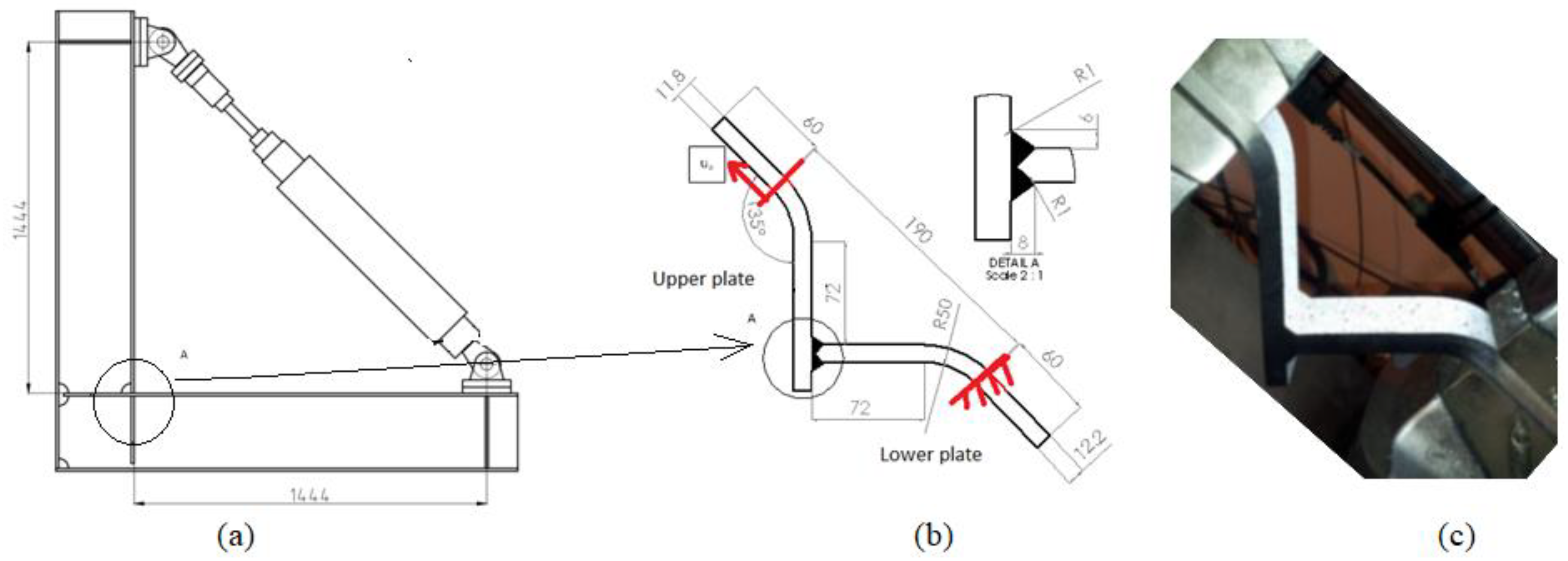
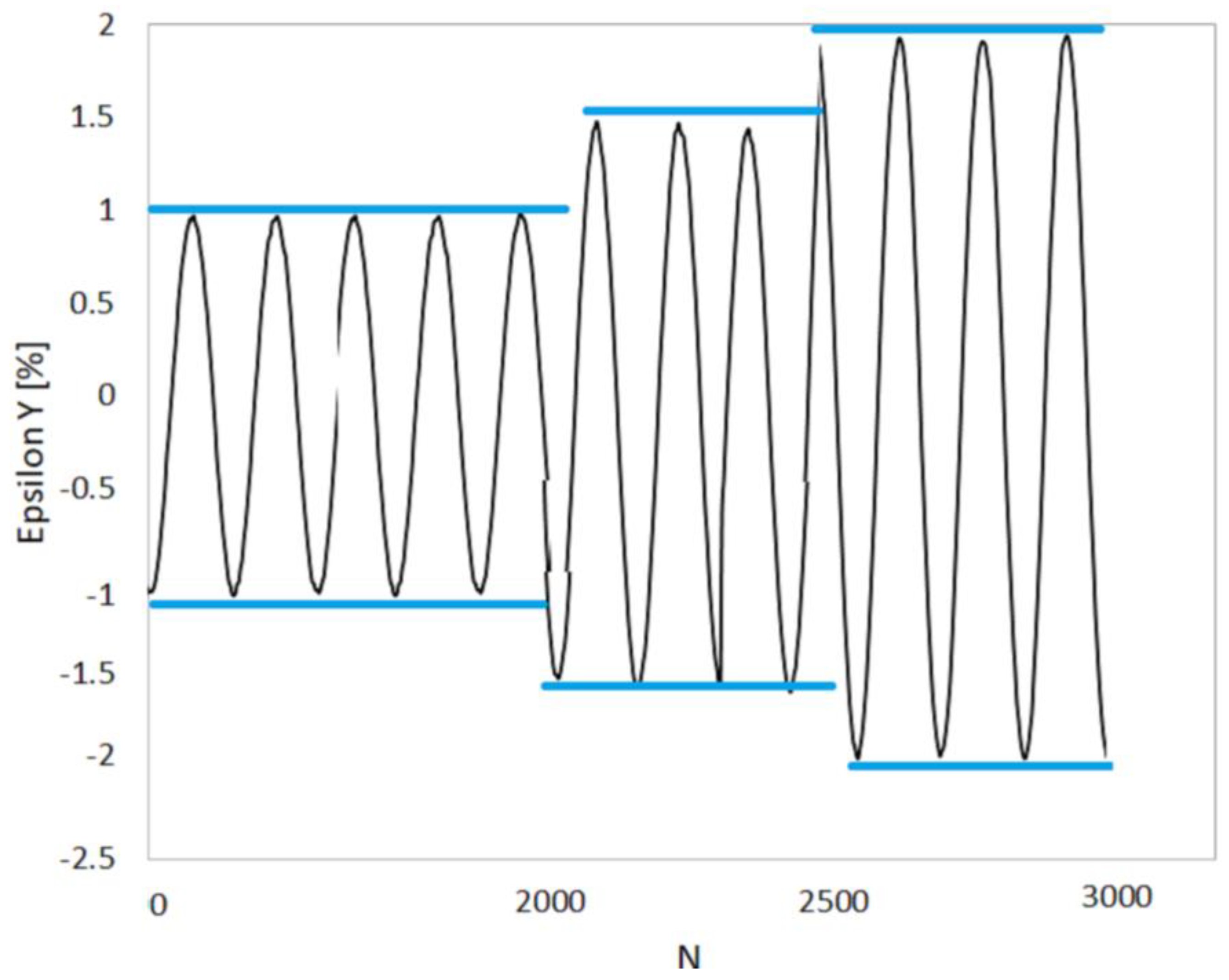
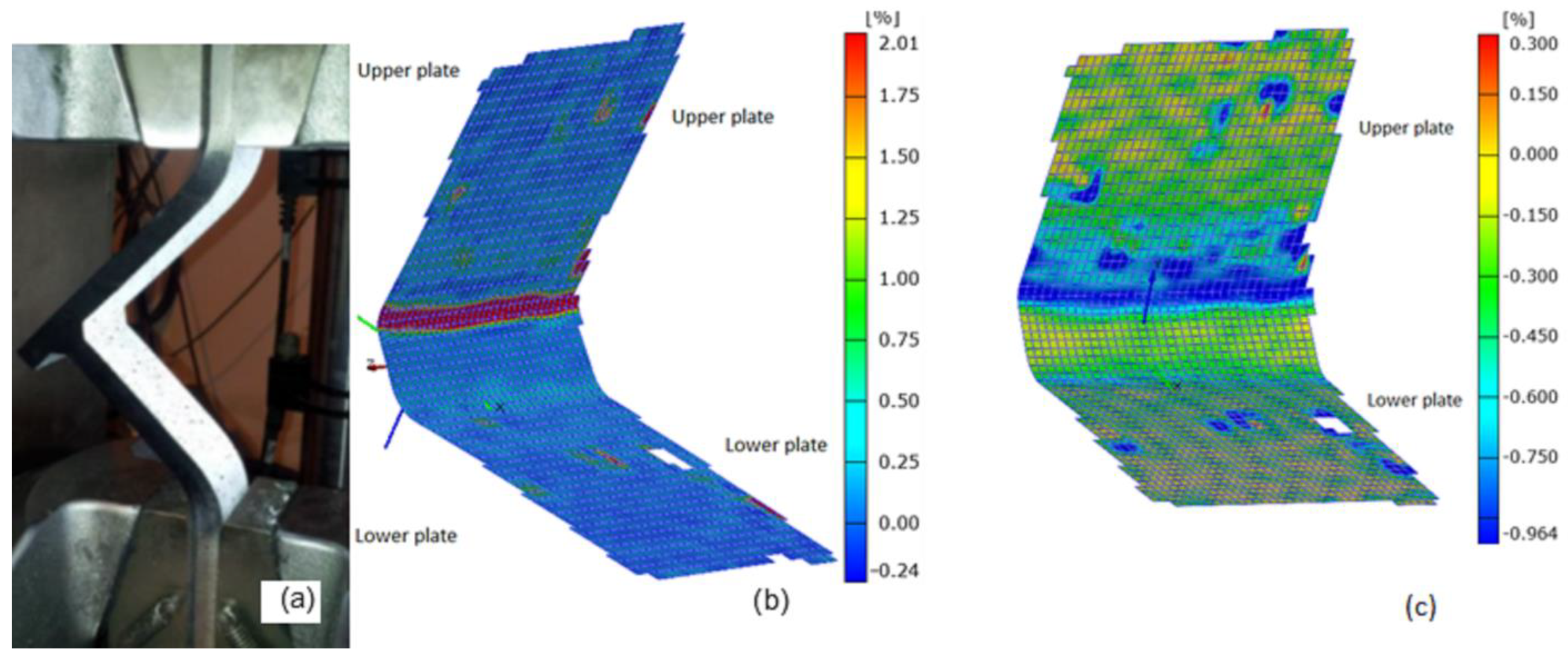

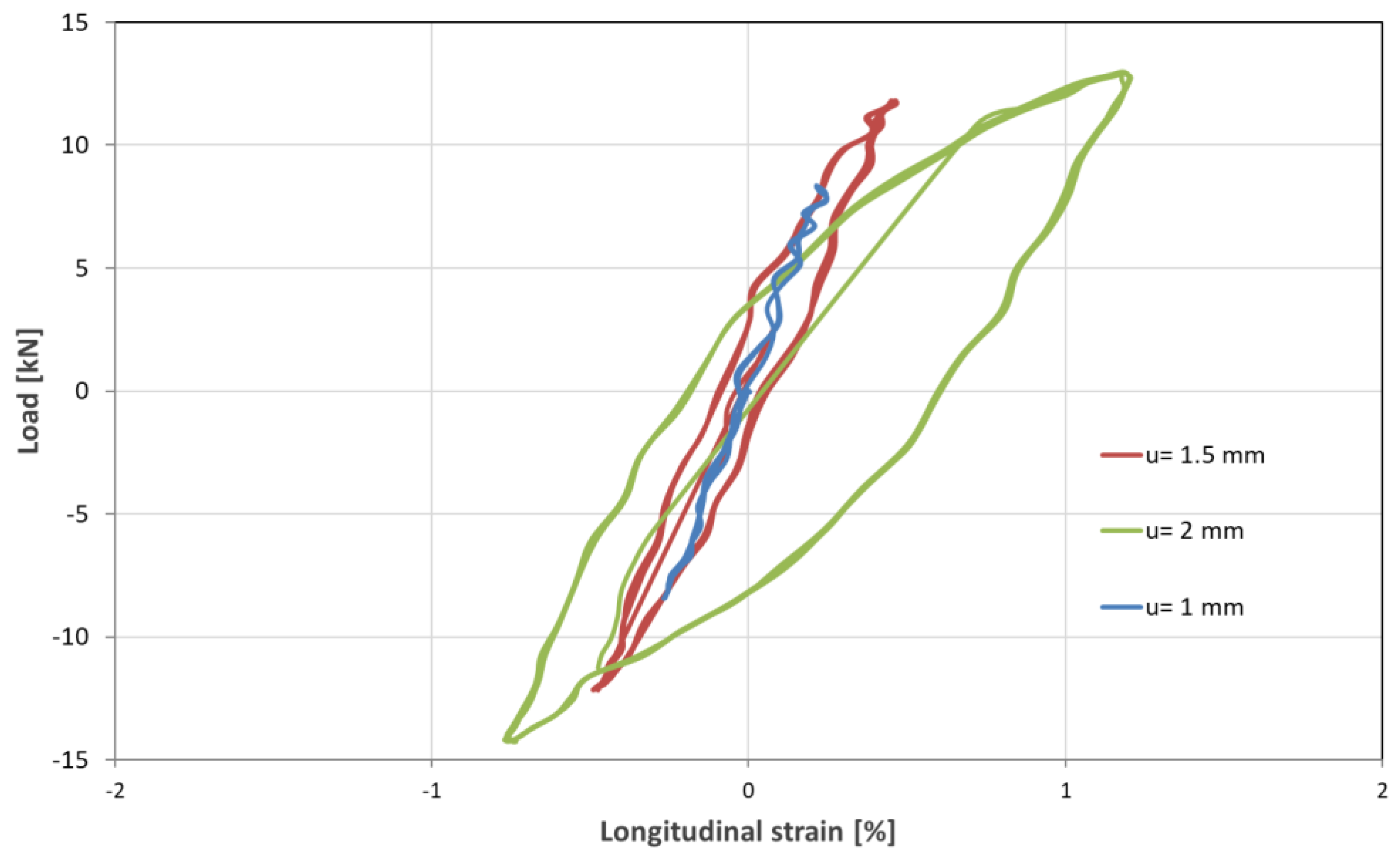
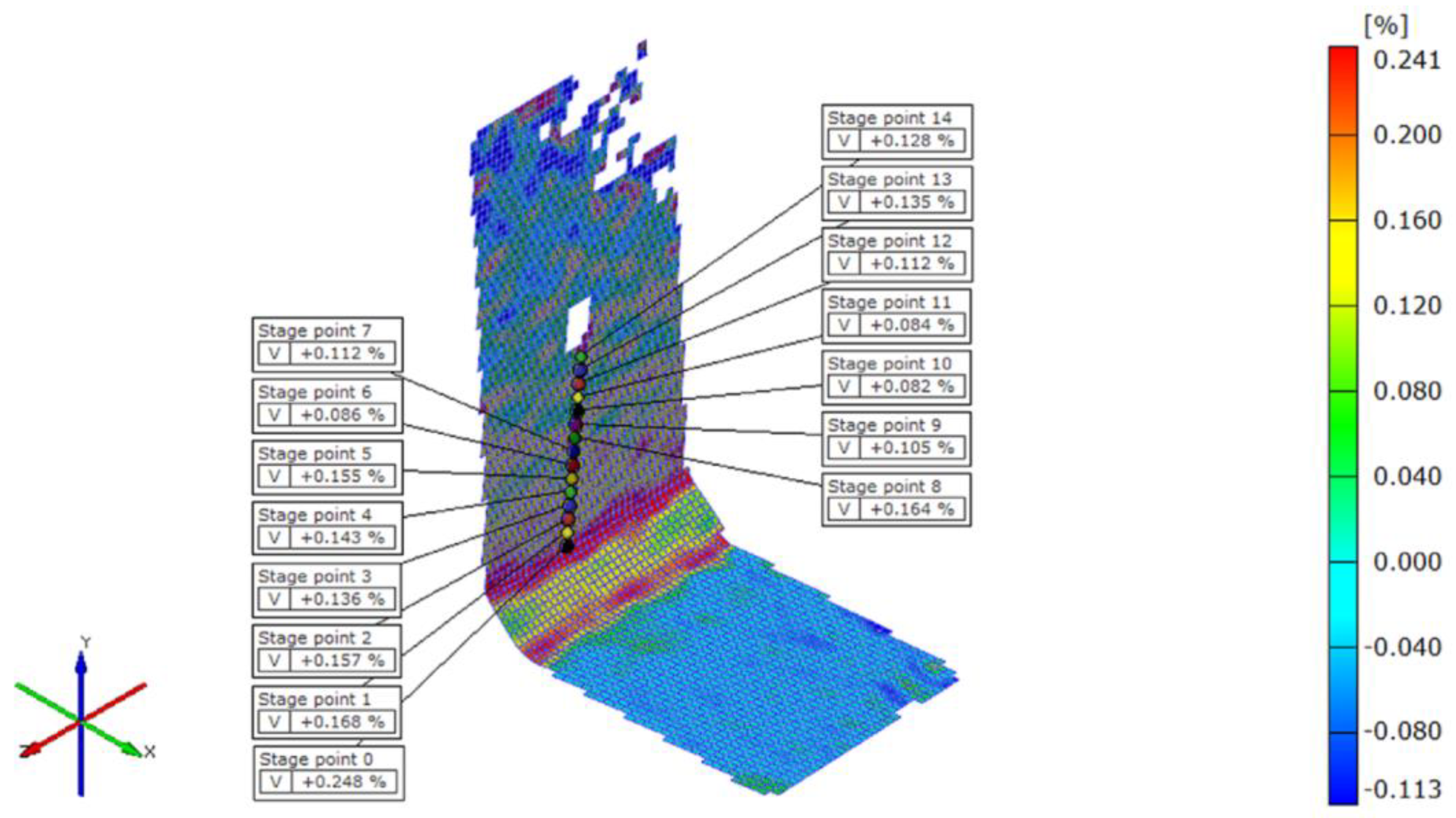

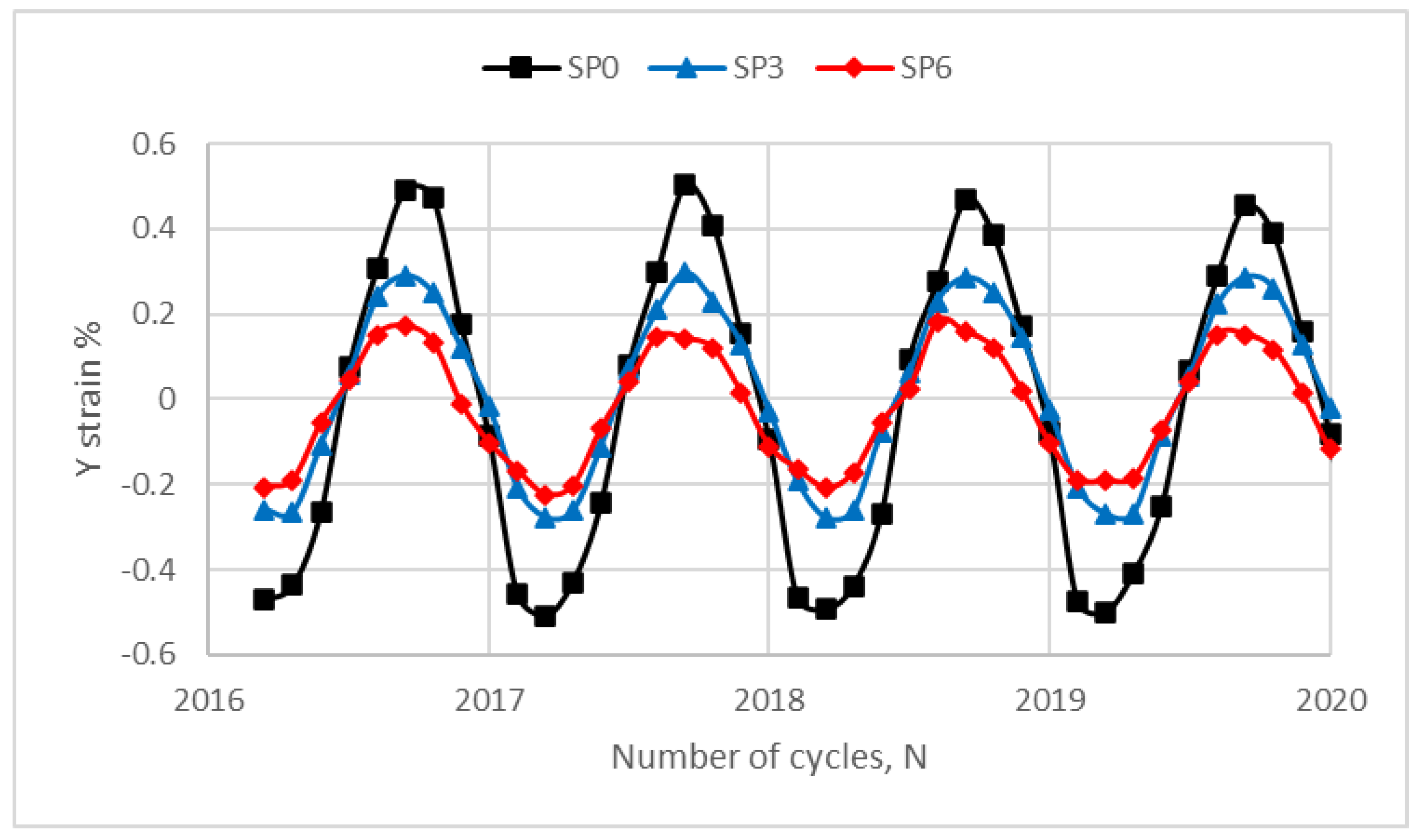
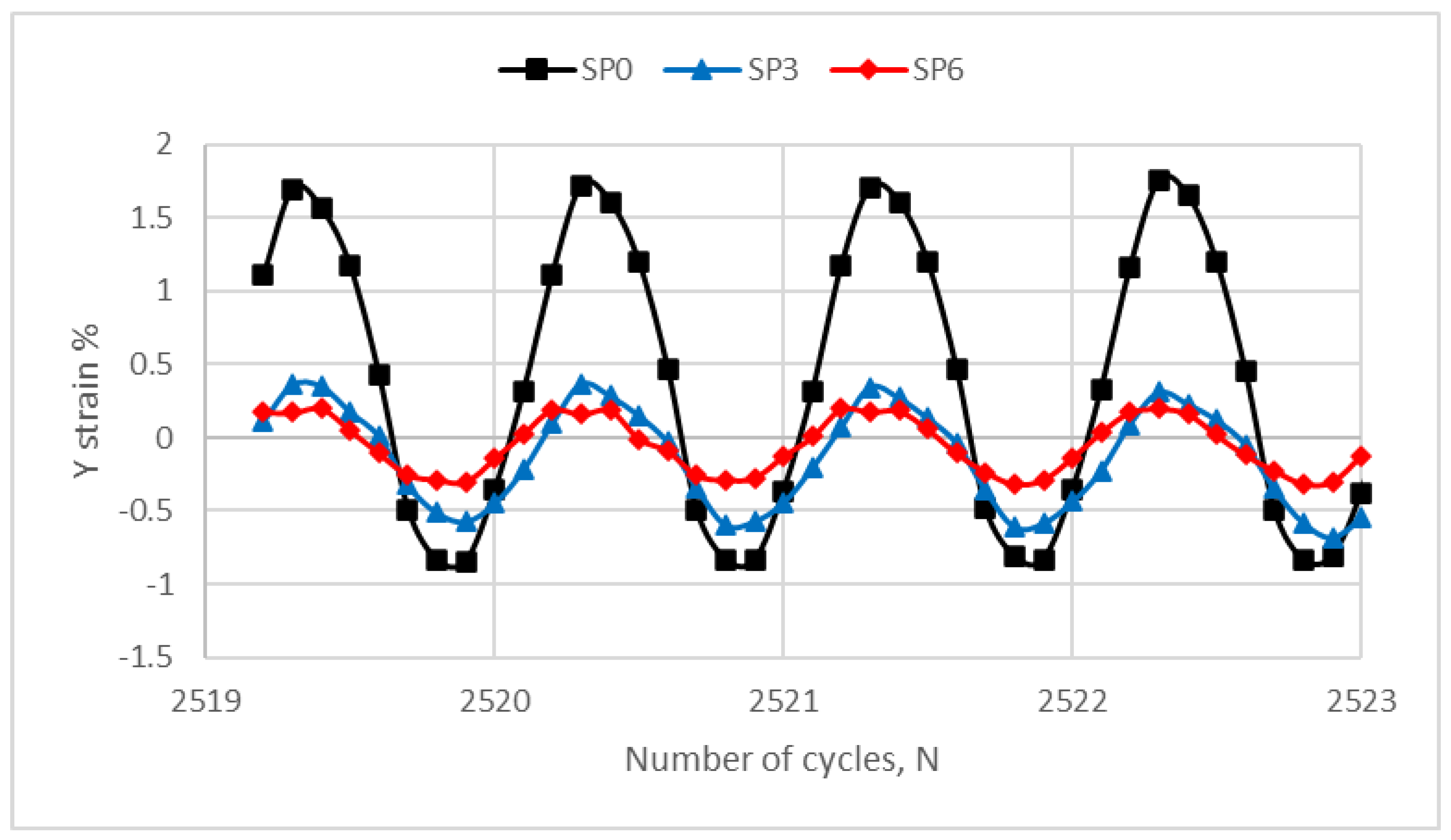
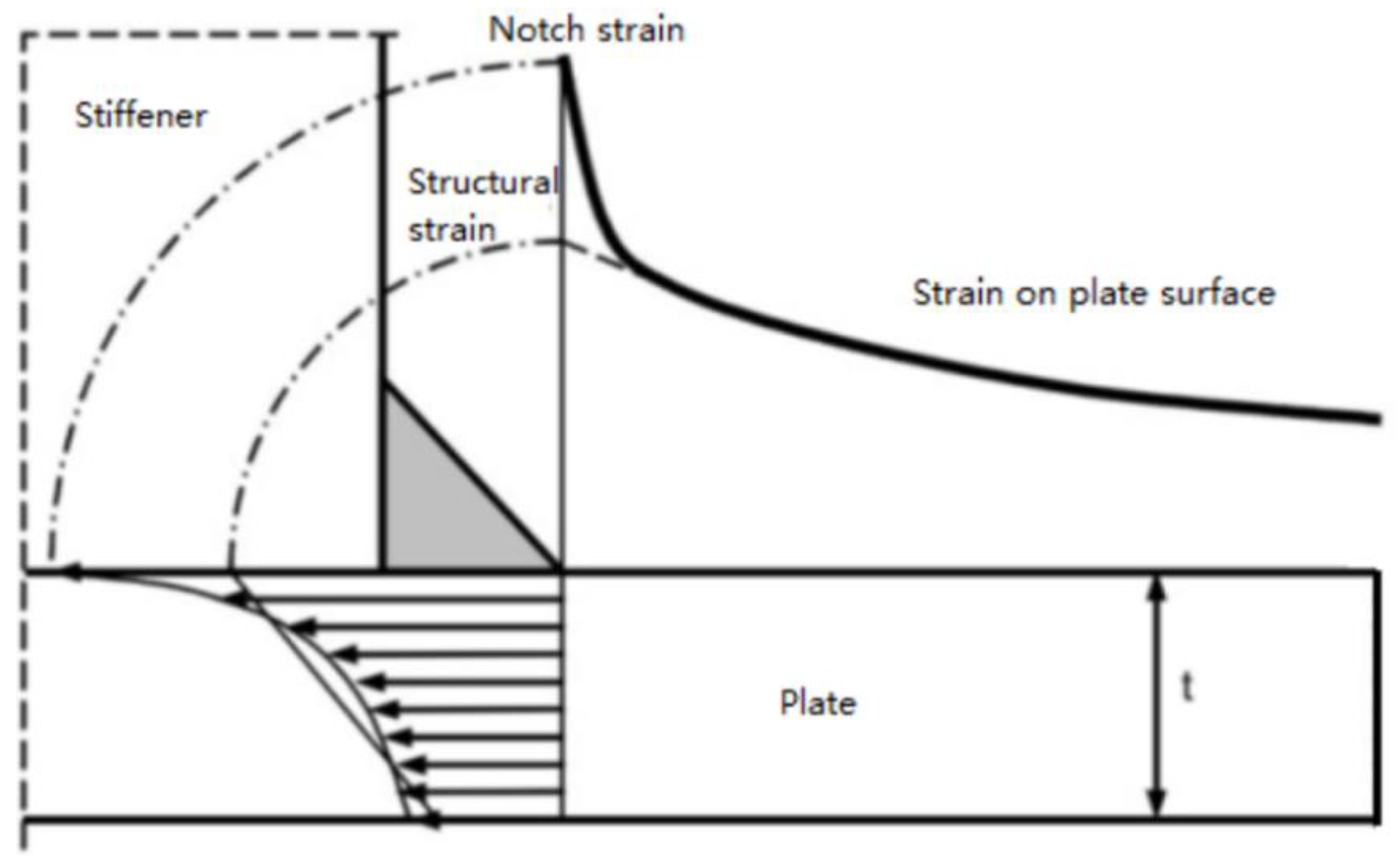
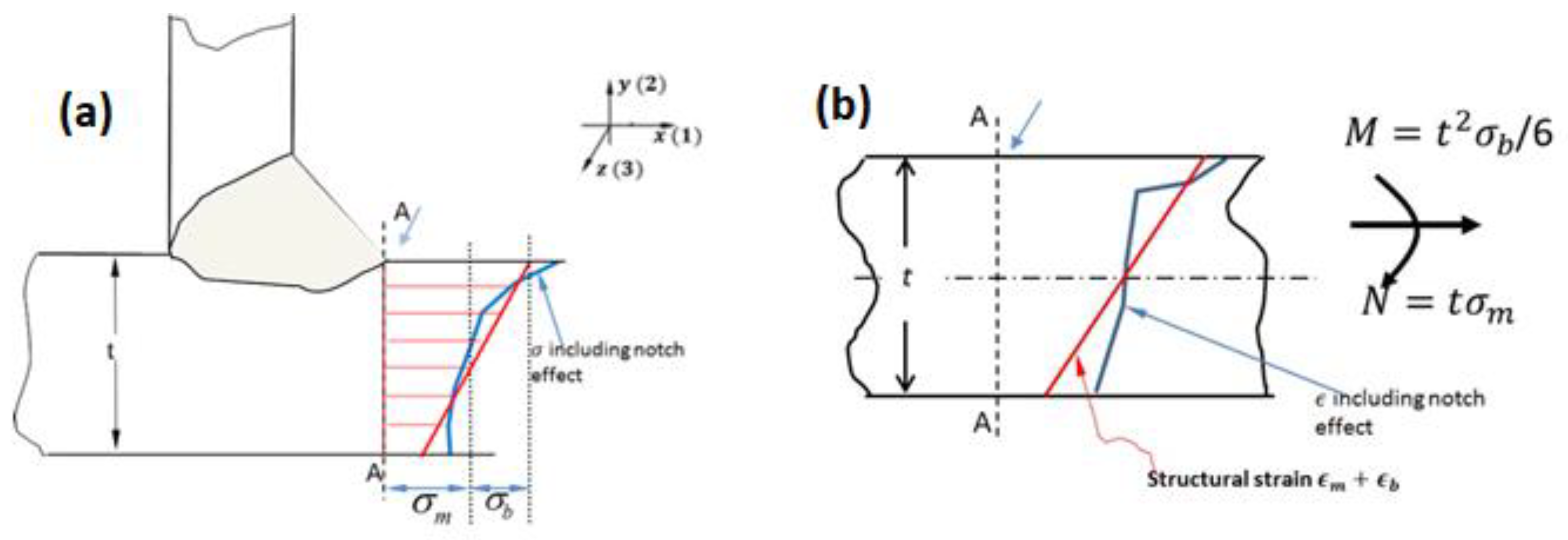
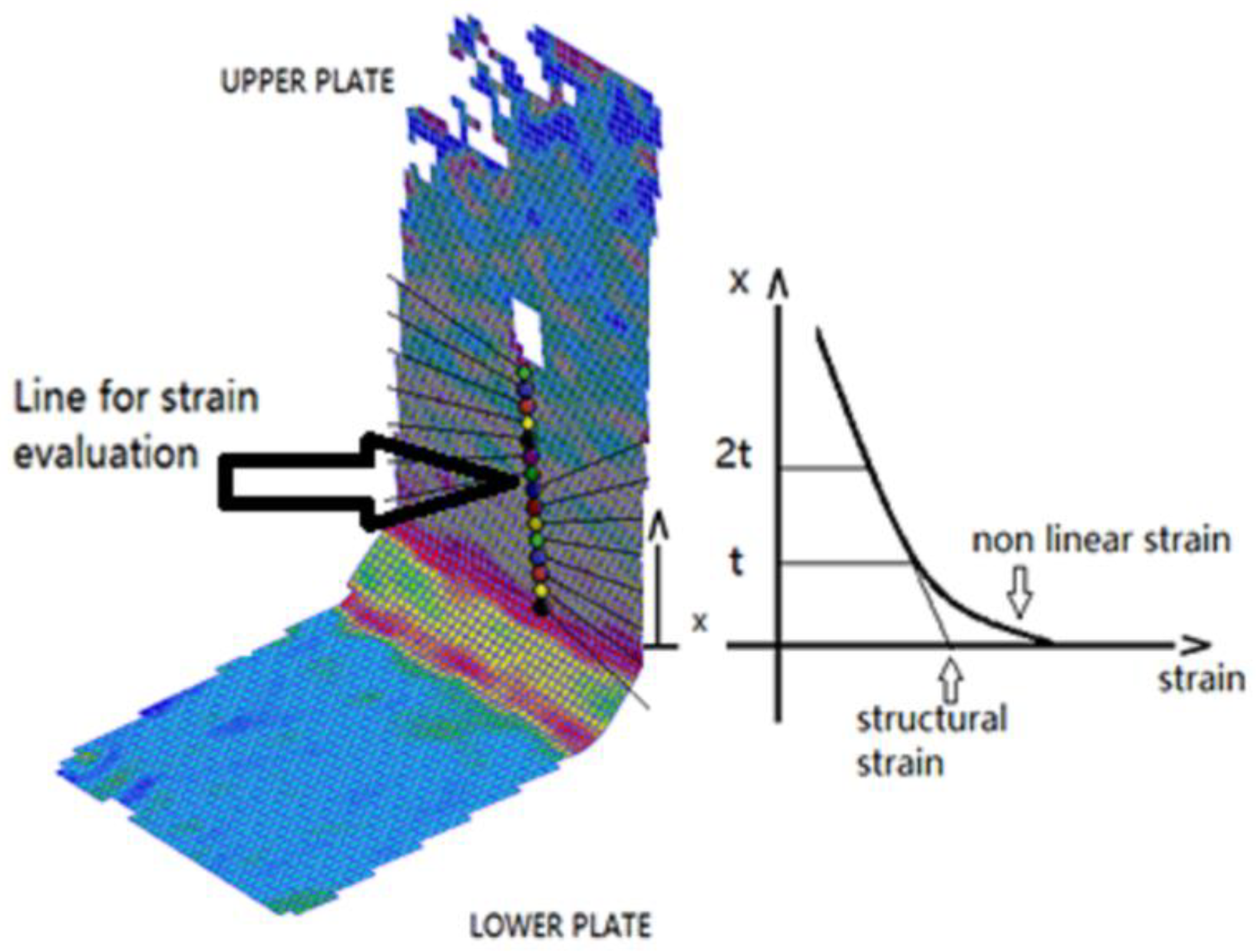
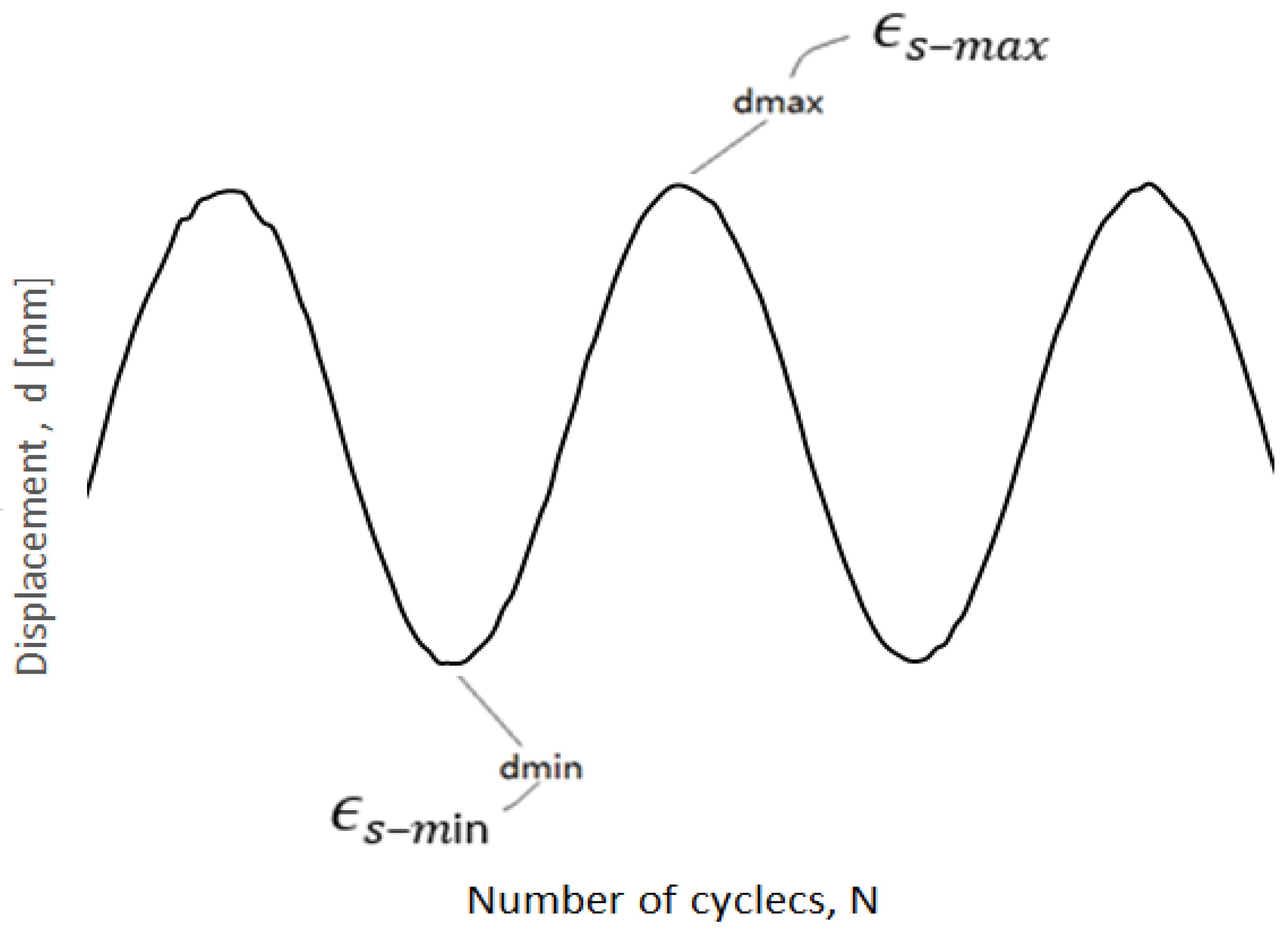
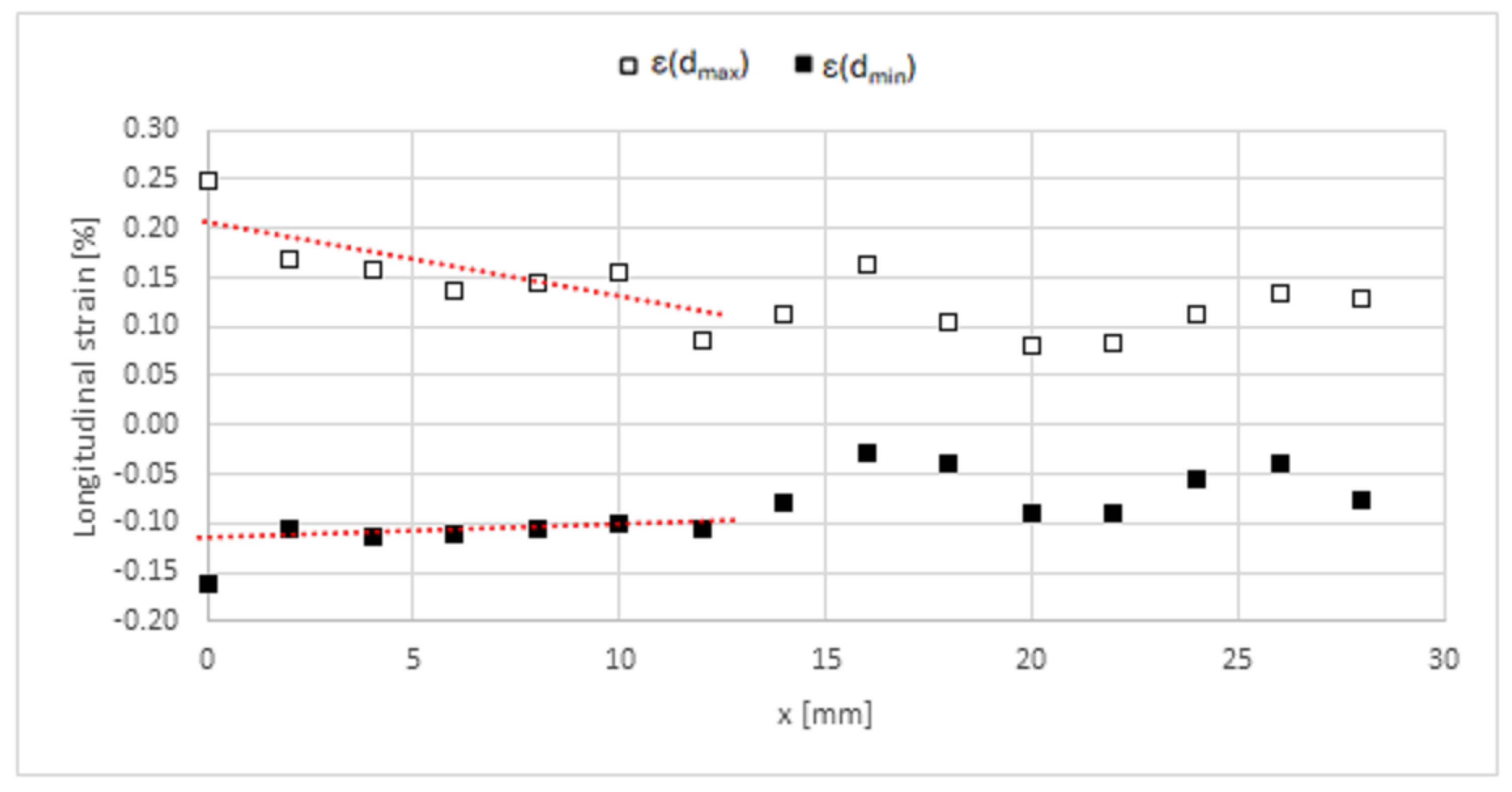
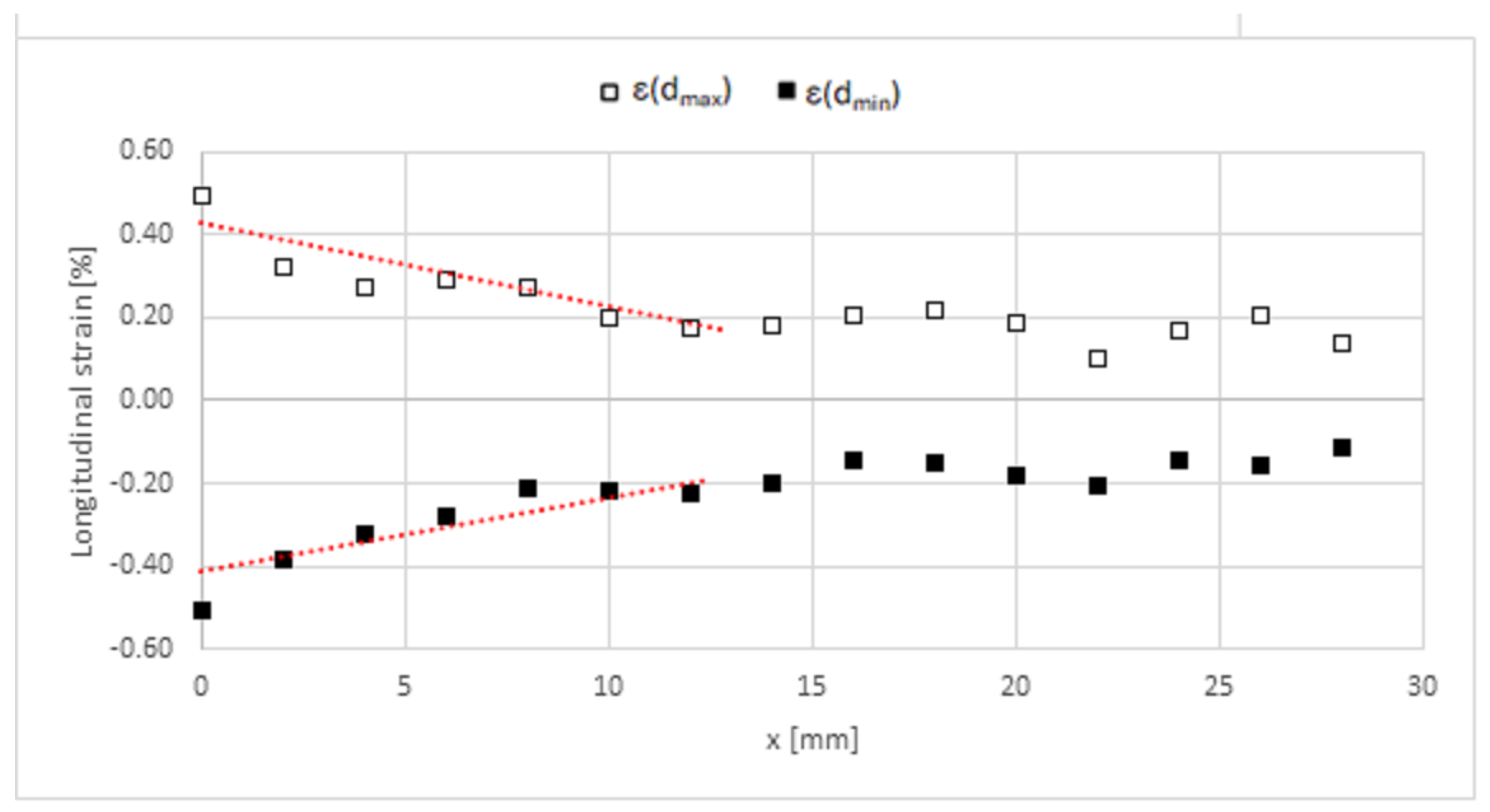
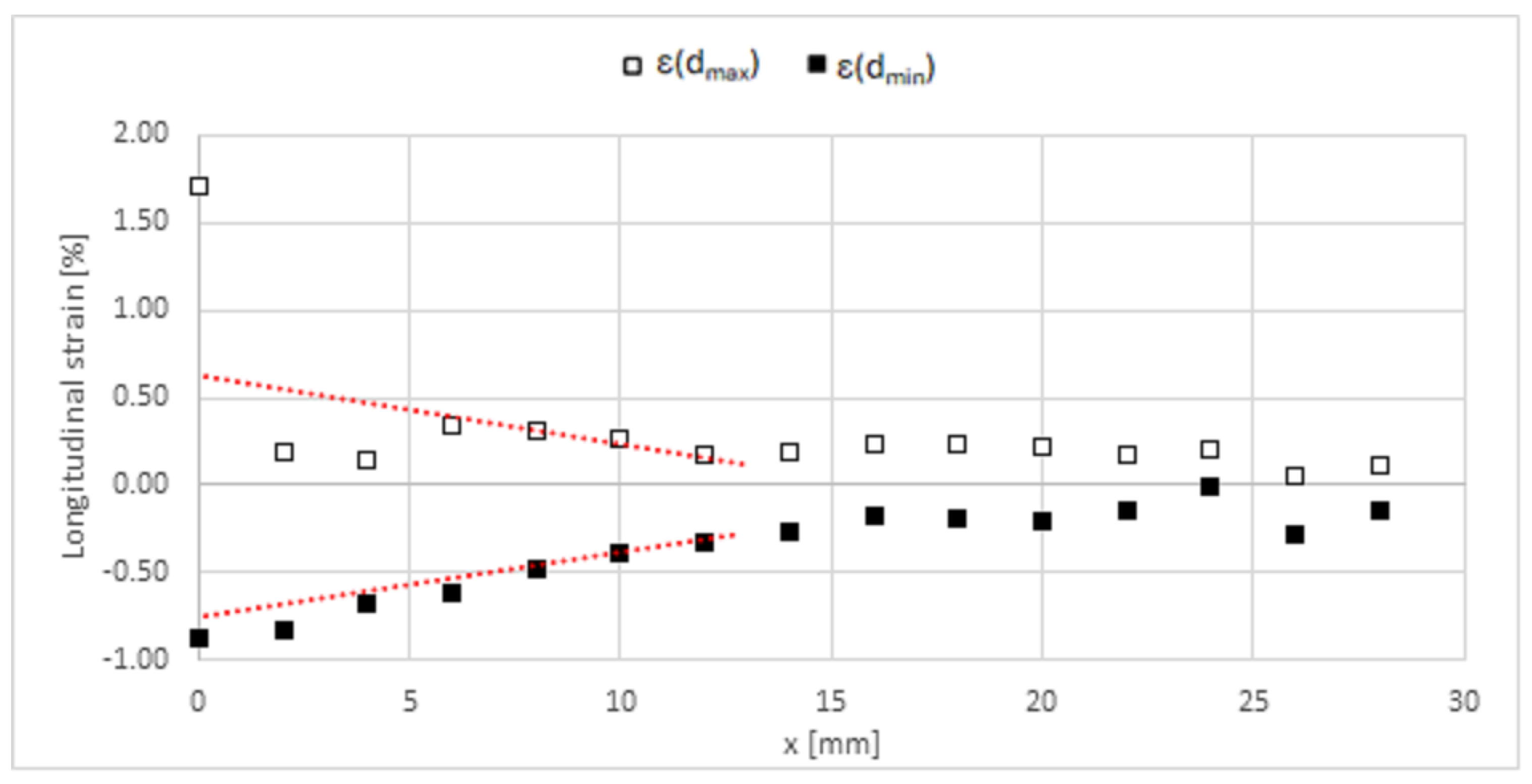
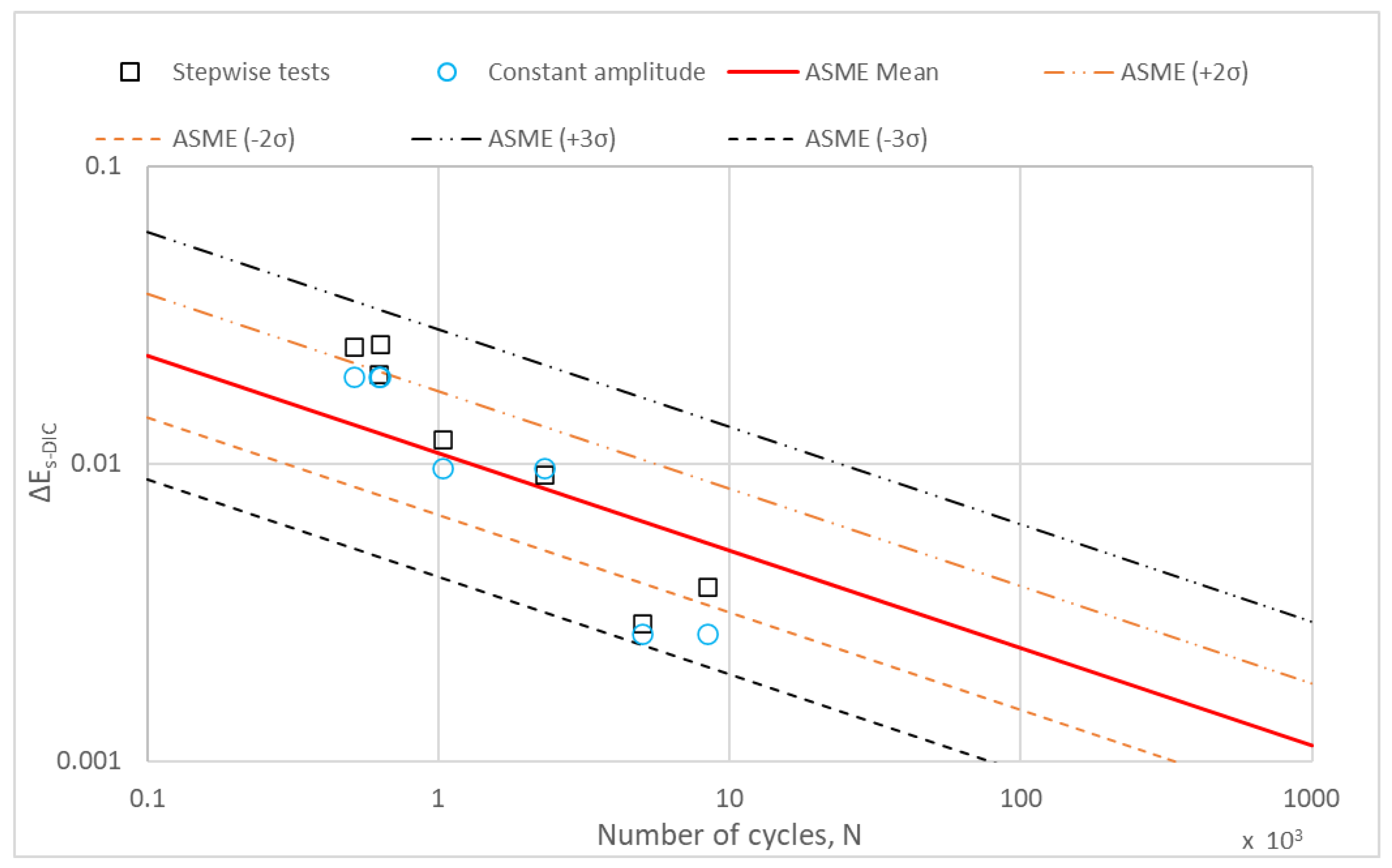
| Test | Displacement Amplitude ua [mm] | Test Frequency f [Hz] | Cycles to Failure Nf_exp |
|---|---|---|---|
| 1 | 2.5 | 0.1 | 375 |
| 2 | 2.5 | 0.1 | 430 |
| 3 | 2 | 1 | 620 |
| 4 | 2 | 1 | 628 |
| 5 | 2 | 0.1 | 510 |
| 6 | 1.5 | 1 | 1028 |
| 7 | 1.5 | 1 | 2312 |
| 8 | 1 | 1 | 5000 |
| 9 | 1 | 1 | 8400 |
| 10 | 1–1.5–2 | 1 | Stepwise test |
| 11 | 1–1.5–2 | 1 | Stepwise test |
| da [mm] | ϵs−max % | ϵs−min % | Δϵs % |
|---|---|---|---|
| 1 | 0.2124 | −0.1352 | 0.003476 |
| 1.5 | 0.4177 | −0.446 | 0.008637 |
| 2 | 0.9082 | −0.8902 | 0.017984 |
| da [mm] | da−x [mm] | ϵm | ϵb |
|---|---|---|---|
| 1 | 0.36731937 | 0.00510166 | −0.0016257 |
| 1.5 | 0.550979052 | 0.007652487 | 0.000984513 |
| 2 | 0.734638735 | 0.010203316 | 0.007780684 |
| ua [mm] | r | I(r)1/m |
|---|---|---|
| 1 | −0.4676806 | 1.21102561 |
| 1.5 | 0.113987863 | 1.222712058 |
| 2 | 0.432644808 | 1.231805941 |
| ua | Nf | Stepwise Tests ΔEs | Constant-Amplitude Tests ΔEs |
|---|---|---|---|
| 1 | 5000 | 0.0029 | 0.0027 |
| 8400 | 0.0038 | 0.0027 | |
| 1.5 | 1028 | 0.0121 | 0.0097 |
| 2312 | 0.0092 | 0.0097 | |
| 2 | 620 | 0.0200 | 0.0196 |
| 628 | 0.0254 | 0.0196 | |
| 510 | 0.0248 | 0.0196 |
Disclaimer/Publisher’s Note: The statements, opinions and data contained in all publications are solely those of the individual author(s) and contributor(s) and not of MDPI and/or the editor(s). MDPI and/or the editor(s) disclaim responsibility for any injury to people or property resulting from any ideas, methods, instructions or products referred to in the content. |
© 2024 by the authors. Licensee MDPI, Basel, Switzerland. This article is an open access article distributed under the terms and conditions of the Creative Commons Attribution (CC BY) license (https://creativecommons.org/licenses/by/4.0/).
Share and Cite
Corigliano, P.; Dong, P. Digital Image Correlation Structural Strain Analysis of S235 Fillet-Welded Joints under Low-Cycle Fatigue Loadings. J. Mar. Sci. Eng. 2024, 12, 531. https://doi.org/10.3390/jmse12040531
Corigliano P, Dong P. Digital Image Correlation Structural Strain Analysis of S235 Fillet-Welded Joints under Low-Cycle Fatigue Loadings. Journal of Marine Science and Engineering. 2024; 12(4):531. https://doi.org/10.3390/jmse12040531
Chicago/Turabian StyleCorigliano, Pasqualino, and Pingsha Dong. 2024. "Digital Image Correlation Structural Strain Analysis of S235 Fillet-Welded Joints under Low-Cycle Fatigue Loadings" Journal of Marine Science and Engineering 12, no. 4: 531. https://doi.org/10.3390/jmse12040531
APA StyleCorigliano, P., & Dong, P. (2024). Digital Image Correlation Structural Strain Analysis of S235 Fillet-Welded Joints under Low-Cycle Fatigue Loadings. Journal of Marine Science and Engineering, 12(4), 531. https://doi.org/10.3390/jmse12040531







